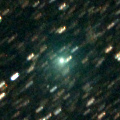
|
Now it is so bright as 9.1 mag (Mar. 15, Juan Jose Gonzalez). It will reach up to 8 mag and to be observable in good condition in spring.
Date(TT) R.A. (2000) Decl. Delta r Elong. m1 Best Time(A, h)
Mar. 20 19 19.61 10 32.8 1.568 1.539 69 9.1 4:40 (292, 44)
Mar. 27 19 29.57 18 19.5 1.449 1.504 73 8.8 4:29 (284, 50)
|
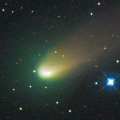
|
Now it is so bright as 9.2 mag (Mar. 19, Marco Goiato). It keeps observable bright as 9-10 mag in a good condition for a long time until spring. It keeps observable until autumn when it fades down to 16 mag.
Date(TT) R.A. (2000) Decl. Delta r Elong. m1 Best Time(A, h)
Mar. 20 14 12.63 -6 38.3 0.696 1.618 145 9.5 2:24 ( 0, 48)
Mar. 27 14 14.47 -6 17.8 0.681 1.630 151 9.5 1:58 ( 0, 49)
|
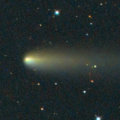
|
It brightened up to 9.5 mag on Jan. 13 (Juan Jose Gonzalez). Now it is still bright as 11.4 mag (Mar. 15, Juan Jose Gonzalez). However, it is fading more rapidly than expected. It will be observable in good condition for a long time after this in the Northern Hemisphere. It keeps visible visually until autumn.
Date(TT) R.A. (2000) Decl. Delta r Elong. m1 Best Time(A, h)
Mar. 20 15 23.31 57 7.1 2.407 2.903 110 10.2 3:34 (180, 68)
Mar. 27 15 23.24 59 2.4 2.470 2.950 109 10.4 3:07 (180, 66)
|

|
It reached up to 7.7 mag in last summer (Aug. 13, Chris Wyatt). It is fading now. It has already faded down to 11.2 mag (Mar. 13, Marco Goiato). In the Southern Hemisphere, it keeps observable for a long time after this. But in the Northern Hemisphere, it is only observable in the low sky in spring, then it will never be observable again.
Date(TT) R.A. (2000) Decl. Delta r Elong. m1 Best Time(A, h)
Mar. 20 20 18.50 -25 44.0 4.395 3.964 58 11.2 4:40 (310, 9)
Mar. 27 20 19.90 -26 39.1 4.319 4.004 65 11.2 4:29 (313, 10)
|

|
It is not brightening at all after it appeared in the morning sky in late January. Now it is still 12.8 mag (Mar. 12, Hidetaka Sato). Hidetaka Sato reported that there was no condensation and it was very diffuse on Mar. 12. This comet seems to disintegrate. However, it was reported so bright as 9.8 mag visually (Mar. 15, Juan Jose Gonzalez). In the Northern Hemisphere, it will be too low in early May. In the Southern Hemisphere, it becomes observable in mid April, after the perihelion passage, but it keeps locating low.
Date(TT) R.A. (2000) Decl. Delta r Elong. m1 Best Time(A, h)
Mar. 20 23 31.02 43 7.4 0.844 0.701 43 12.4 4:40 (227, 14)
Mar. 27 1 26.62 43 54.2 0.810 0.697 43 12.3 19:41 (131, 19)
|

|
It will approach to the sun down to 0.4 A.U. in July, and it is expected to reach up to 4 mag. It keeps unobservable for a while. It will appear in the morning sky at 12 mag in April. In the Northern Hemisphere, it is observable only until June.
Date(TT) R.A. (2000) Decl. Delta r Elong. m1 Best Time(A, h)
Mar. 20 22 22.93 -8 8.5 2.977 2.113 24 13.6 4:40 (278, -3)
Mar. 27 22 32.11 -6 9.2 2.823 2.007 28 13.3 4:29 (277, -1)
|

|
Now it is 14.6 mag (Feb. 6, Ken-ichi Kadota). Appearing in the morining sky. It will brighten up to 12-13 mag in summer. But it locates somewhat low in the Northern Hemisphere.
Date(TT) R.A. (2000) Decl. Delta r Elong. m1 Best Time(A, h)
Mar. 20 19 37.87 -25 8.5 2.651 2.443 67 13.6 4:40 (316, 15)
Mar. 27 19 50.11 -25 5.6 2.575 2.445 71 13.5 4:29 (317, 16)
|

|
Great outburst up to 11 mag occured on Feb. 2. Now it is still bright as 11.7 mag (Mar. 15, Juan Jose Gonzalez).
Date(TT) R.A. (2000) Decl. Delta r Elong. m1 Best Time(A, h)
Mar. 20 9 20.04 13 15.8 5.413 6.200 139 13.6 21:28 ( 0, 68)
Mar. 27 9 18.31 13 20.9 5.493 6.202 131 13.6 20:59 ( 0, 68)
|

|
It brightened up to 15.5 mag in January (Jan. 31, C. Rinner, F. Kugel). It is not observable now. The condition of this apparition is bad. It will reach up to 11-12 mag from spring to autumn in 2010, but it is not observable.
Date(TT) R.A. (2000) Decl. Delta r Elong. m1 Best Time(A, h)
Mar. 20 0 19.54 11 25.8 2.721 1.765 13 13.9 19:35 (109, -6)
Mar. 27 0 37.41 12 49.5 2.689 1.721 11 13.7 19:41 (113, -9)
|
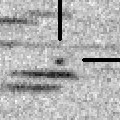
|
Now it is 17.8 mag (Feb. 17, Hidetaka Sato). It will be getting brighter rapidly in the morning sky. It keeps observable bright as 9-10 mag for a long time from spring to autumn.
Date(TT) R.A. (2000) Decl. Delta r Elong. m1 Best Time(A, h)
Mar. 20 18 48.76 -13 24.7 1.720 1.788 77 14.6 4:40 (319, 31)
Mar. 27 19 6.95 -13 7.5 1.626 1.749 79 14.2 4:29 (319, 31)
|

|
It brightened up to 11.5 mag in January (Jan. 12, Juan Jose Gonzalez). It is still bright as 13.1 mag (Mar. 13, Carlos Labordena). In the Northern Hemisphere, it keeps observable in good condition until spring.
Date(TT) R.A. (2000) Decl. Delta r Elong. m1 Best Time(A, h)
Mar. 20 6 29.87 18 35.9 1.688 2.075 97 14.2 19:35 ( 41, 69)
Mar. 27 6 41.04 19 3.3 1.776 2.091 93 14.5 19:41 ( 53, 66)
|
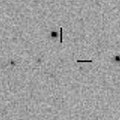
|
It was observed as 15.6 mag at the end of last year (Dec. 6, A. Maury, J. B. de Vanssay, F. Mallia, F. Kugel). It will be 14 mag from winter to spring in 2010. But the condition is bad. Now it is not observable. In the Northern Hemisphere, it will appear in the morning sky at 15 mag in late May, then it keeps observable while fading gradually after that.
Date(TT) R.A. (2000) Decl. Delta r Elong. m1 Best Time(A, h)
Mar. 20 0 3.66 5 54.2 2.721 1.736 6 14.3 19:35 (107,-13)
Mar. 27 0 16.66 9 13.2 2.736 1.750 6 14.3 4:29 (249,-13)
|
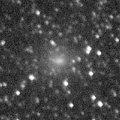
|
It reached up to 8.4 mag in October (Oct. 20, Marco Goiato). It has faded down to 14.4 mag in February (Feb. 28, Ken-ichi Kadota), and it became unobservable. It will not be observable after this.
Date(TT) R.A. (2000) Decl. Delta r Elong. m1 Best Time(A, h)
Mar. 20 0 55.55 4 2.8 3.047 2.103 15 15.0 19:35 ( 98, -4)
Mar. 27 1 9.47 5 35.4 3.114 2.149 12 15.3 19:41 (102, -7)
|

|
It brightened up to 11 mag in spring and summer in 2009. Appearing in the morninig sky again. It keeps observable after this until autumn when it becomes fainter than 18 mag while fading gradually. But it locates somewhat low in the Northern Hemisphere.
Date(TT) R.A. (2000) Decl. Delta r Elong. m1 Best Time(A, h)
Mar. 20 19 26.40 -25 8.3 2.903 2.723 69 15.1 4:40 (319, 17)
Mar. 27 19 35.34 -24 57.6 2.839 2.748 74 15.2 4:29 (320, 18)
|
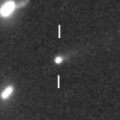
|
Now it is 15.6 mag (Mar. 17, Toshiyuki Takahashi). It was expected to be observable at 15 mag in good condition from winter to spring. But actually, it had been much fainter than expected until January. However, it is brightening very rapidly in February.
Date(TT) R.A. (2000) Decl. Delta r Elong. m1 Best Time(A, h)
Mar. 20 10 9.82 22 23.0 1.346 2.241 145 15.2 22:18 ( 0, 77)
Mar. 27 10 7.93 22 11.4 1.390 2.240 138 15.2 21:49 ( 0, 77)
|

|
Now it is 13.3 mag, already visible visually (Feb. 3, Marco Goiato). It will be observable at 15 mag in good condition in winter and spring.
Date(TT) R.A. (2000) Decl. Delta r Elong. m1 Best Time(A, h)
Mar. 20 5 48.14 23 15.3 1.655 1.903 88 15.2 19:35 ( 68, 66)
Mar. 27 6 1.75 23 47.4 1.713 1.896 84 15.3 19:41 ( 74, 62)
|

|
Now it is visible visually at 14.5 mag (Mar. 15, Juan Jose Gonzalez). It will be bright as 14-15 mag in spring. It keeps observable for a long time until September when it becomes fainter than 18 mag.
Date(TT) R.A. (2000) Decl. Delta r Elong. m1 Best Time(A, h)
Mar. 20 15 27.65 -28 41.3 0.997 1.742 121 15.4 3:39 ( 0, 26)
Mar. 27 15 38.32 -29 30.2 0.941 1.730 126 15.2 3:22 ( 0, 25)
|
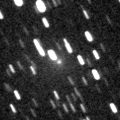
|
Now it is 14.9 mag (Feb. 20, Ken-ichi Kadota). It has a very faint large coma. It was observed so bright as 13.5 mag in January (Jan. 16, Michael Jager).
Date(TT) R.A. (2000) Decl. Delta r Elong. m1 Best Time(A, h)
Mar. 20 1 52.20 64 46.1 1.436 1.414 68 15.3 19:35 (150, 34)
Mar. 27 2 20.00 68 19.9 1.429 1.418 68 15.3 19:41 (154, 34)
|
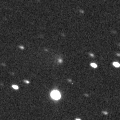
|
It will be observable at 12-13 mag for a long time from 2011 to 2012. It is getting higher gradually after this. In 2010, it is observable at 14 mag in good condition from spring to autumn.
Date(TT) R.A. (2000) Decl. Delta r Elong. m1 Best Time(A, h)
Mar. 20 21 56.57 0 5.7 8.399 7.553 30 15.4 4:40 (275, 7)
Mar. 27 21 57.85 0 20.1 8.301 7.518 36 15.4 4:29 (277, 10)
|

|
Now it is 15.5 mag (Feb. 14, E. Bryssinck, S. Farmer, Jr., P. Camilleri, S. Plaksa). It was observed as 15-16 mag in early 2009. In 2010, it will be observable at 16 mag in good condition from winter to spring.
Date(TT) R.A. (2000) Decl. Delta r Elong. m1 Best Time(A, h)
Mar. 20 13 55.18 -3 55.3 2.750 3.647 150 15.4 2:07 ( 0, 51)
Mar. 27 13 51.83 -3 34.6 2.710 3.652 157 15.4 1:36 ( 0, 51)
|
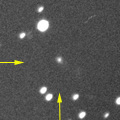
|
Now it is 15.5 mag (Feb. 20, S. Plaksa, E. Bryssinck). It keeps observable at 15 mag for a long time in 2010.
Date(TT) R.A. (2000) Decl. Delta r Elong. m1 Best Time(A, h)
Mar. 20 17 54.73 22 38.3 4.658 4.773 90 15.6 4:40 (298, 68)
Mar. 27 17 57.97 24 15.7 4.571 4.755 94 15.6 4:29 (300, 71)
|
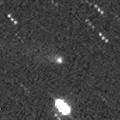
|
Now it is 16.6 mag (Feb. 18, Ken-ichi Kadota), a bit fainter than this ephemeris. It will be observable at 16 mag in good condition until spring.
Date(TT) R.A. (2000) Decl. Delta r Elong. m1 Best Time(A, h)
Mar. 20 14 16.94 28 45.3 2.511 3.301 136 15.7 2:29 ( 0, 84)
Mar. 27 13 58.92 29 12.1 2.505 3.339 140 15.7 1:44 ( 0, 84)
|

|
It brightned up to 10 mag from late 2008 to early 2009. Now it is fading. But it is still bright as 15.8 mag (Feb. 16, Catalina Sky Survey). It keeps observable in good condition at 16 mag for a while.
Date(TT) R.A. (2000) Decl. Delta r Elong. m1 Best Time(A, h)
Mar. 20 9 44.52 3 49.6 5.053 5.911 146 15.9 21:53 ( 0, 59)
Mar. 27 9 42.03 3 55.6 5.171 5.964 139 16.0 21:23 ( 0, 59)
|

|
Now it is 15.4 mag (Feb. 14, C. Rinner, F. Kugel). It brightened up to 11 mag in outburst in 2003. However, it does not seem to be so bright in this apparition. It seems to be 16 mag at best.
Date(TT) R.A. (2000) Decl. Delta r Elong. m1 Best Time(A, h)
Mar. 20 4 25.39 22 56.6 1.394 1.396 69 16.0 19:35 ( 85, 49)
Mar. 27 4 51.81 23 7.5 1.439 1.415 68 16.1 19:41 ( 87, 48)
|

|
It brightened up to 13 mag and observed visually from 2007 to 2009. Due to the far distance, it is bright as 14.9 mag still now (Jan. 15, Ken-ichi Kadota). It will be observable in good condition again until spring.
Date(TT) R.A. (2000) Decl. Delta r Elong. m1 Best Time(A, h)
Mar. 20 12 39.41 42 0.3 7.136 7.896 137 16.2 0:51 (180, 83)
Mar. 27 12 32.49 42 25.5 7.191 7.929 135 16.3 0:17 (180, 83)
|
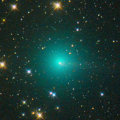
|
It brightened up to 6.7 mag in 2009 June (June 9, Marco Goiato). Now it is 16.0 mag (Mar. 9, Hidetaka Sato). It will be fading after this, and keeps observable until spring when it becomes fainter than 18 mag.
Date(TT) R.A. (2000) Decl. Delta r Elong. m1 Best Time(A, h)
Mar. 20 11 13.27 57 10.8 3.013 3.646 122 16.6 23:20 (180, 68)
Mar. 27 10 52.62 57 37.0 3.144 3.710 117 16.9 22:32 (180, 67)
|
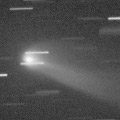
|
It reached up to 8.5 mag on Oct. 15 (Toru Yusa). Now it is fading. It has already faded down to 16.6 mag (Feb. 20, P. Bacci). In the Northern Hemisphere, it keeps observable in good condition for a long time until spring when it becomes fainter than 18 mag.
Date(TT) R.A. (2000) Decl. Delta r Elong. m1 Best Time(A, h)
Mar. 20 6 12.72 21 5.6 2.208 2.482 93 16.8 19:35 ( 54, 69)
Mar. 27 6 21.33 21 30.2 2.353 2.538 88 17.1 19:41 ( 65, 65)
|
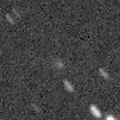
|
Now it is 16.4 mag (Feb. 13, Catalina Sky Survey). It keeps observable at 17 mag in good condition for a while. It will be fainter than 18 mag in June.
Date(TT) R.A. (2000) Decl. Delta r Elong. m1 Best Time(A, h)
Mar. 20 3 55.68 27 40.1 1.807 1.631 63 16.9 19:35 ( 96, 45)
Mar. 27 4 16.14 29 13.3 1.843 1.624 61 16.9 19:41 ( 99, 43)
|
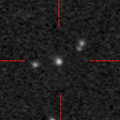
|
Now it is 17.6 mag (Jan. 31, Ken-ichi Kadota). It keeps observable at 17 mag until spring. It will reach up to 14 mag and will be observable in good condition in the next winter.
Date(TT) R.A. (2000) Decl. Delta r Elong. m1 Best Time(A, h)
Mar. 20 5 56.05 60 26.4 4.171 4.291 90 17.2 19:35 (157, 61)
Mar. 27 5 54.96 58 32.1 4.225 4.245 84 17.2 19:41 (148, 59)
|
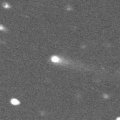
|
Now it is 16.3 mag (Jan. 23, Ken-ichi Kadota). This comet tends to brighten after the perihelion passage. It will be observable at 16 mag in 2010 and 2011. It is brighter than this ephemeris recently.
Date(TT) R.A. (2000) Decl. Delta r Elong. m1 Best Time(A, h)
Mar. 20 4 56.12 23 30.4 3.276 3.189 76 17.2 19:35 ( 81, 56)
Mar. 27 5 4.13 23 36.3 3.372 3.192 71 17.2 19:41 ( 85, 50)
|
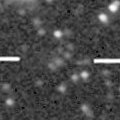
|
Now it is 17.3 mag (Jan. 23, Ken-ichi Kadota). It keeps observable at 17.5 mag in good condition for a long time in 2010.
Date(TT) R.A. (2000) Decl. Delta r Elong. m1 Best Time(A, h)
Mar. 20 23 3.35 70 46.2 5.072 4.852 71 17.4 4:40 (202, 30)
Mar. 27 23 7.89 71 28.4 5.097 4.849 70 17.4 4:29 (202, 31)
|
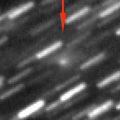
|
It became very bright and observed visually as 9.2 mag (Nov. 18, Juan Jose Gonzalez) and 11.6 mag (Dec. 7, Chris Wyatt) until around the perihelion passage. In January, it approached to the earth down to 0.2 A.U. But it is fading rapidly now. Now it is 17.3 mag (Mar. 11, Yasukazu Ikari). It will be fainter than 18 mag in March.
Date(TT) R.A. (2000) Decl. Delta r Elong. m1 Best Time(A, h)
Mar. 20 8 47.19 10 13.6 0.960 1.786 131 17.6 20:56 ( 0, 65)
Mar. 27 8 51.96 11 14.8 1.091 1.861 125 18.0 20:33 ( 0, 66)
|

|
Now it is 17.4 mag (Feb. 17, Hidetaka Sato). It will be fainter than 18 mag in April.
Date(TT) R.A. (2000) Decl. Delta r Elong. m1 Best Time(A, h)
Mar. 20 18 54.48 33 58.0 6.532 6.405 78 17.9 4:40 (261, 60)
Mar. 27 18 56.98 34 55.1 6.527 6.455 81 17.9 4:29 (261, 63)
|
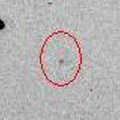
|
Now it is 17.4 mag (Mar. 6, C. Rinner, F. Kugel). It will reach up to 15 mag and will be observable in good condition from autum to winter in 2010. In the Northern Hemisphere, it keeps observable for a long time while it is brightening gradually.
Date(TT) R.A. (2000) Decl. Delta r Elong. m1 Best Time(A, h)
Mar. 20 10 41.71 70 56.0 3.668 4.092 108 17.9 22:48 (180, 54)
Mar. 27 10 20.94 71 41.4 3.691 4.040 103 17.9 22:00 (180, 53)
|

|
New periodic comet which brightened up to 14 mag in 2004 and 2005. It should be observable at 18 mag also around the aphelion. However, no observations have been reported since 2008 January. It seems to have faded out rapidly. Now it is fainter than 20.4 mag actually (Sept. 16, Leonid Elenin).
Date(TT) R.A. (2000) Decl. Delta r Elong. m1 Best Time(A, h)
Mar. 20 6 18.25 31 3.7 4.700 4.885 94 20.2 19:35 ( 79, 75)
Mar. 27 6 20.36 31 0.5 4.801 4.875 88 20.3 19:41 ( 86, 69)
|
|
![]()
 65P/Gunn
65P/Gunn 29P/Schwassmann-Wachmann 1
29P/Schwassmann-Wachmann 1 43P/Wolf-Harrington
43P/Wolf-Harrington 10P/Tempel 2
10P/Tempel 2 118P/Shoemaker-Levy 4
118P/Shoemaker-Levy 4 126P/IRAS
126P/IRAS 88P/Howell
88P/Howell 116P/Wild 4
116P/Wild 4 94P/Russell 4
94P/Russell 4 30P/Reinmuth 1
30P/Reinmuth 1 P/2010 A5 ( LINEAR )
P/2010 A5 ( LINEAR ) C/2009 U3 ( Hill )
C/2009 U3 ( Hill ) C/2006 S3 ( LONEOS )
C/2006 S3 ( LONEOS ) 74P/Smirnova-Chernykh
74P/Smirnova-Chernykh C/2008 FK75 ( Lemmon-Siding Spring )
C/2008 FK75 ( Lemmon-Siding Spring ) C/2008 N1 ( Holmes )
C/2008 N1 ( Holmes ) C/2006 OF2 ( Broughton )
C/2006 OF2 ( Broughton ) 157P/Tritton
157P/Tritton C/2005 L3 ( McNaught )
C/2005 L3 ( McNaught ) C/2008 Q3 ( Garradd )
C/2008 Q3 ( Garradd ) 217P/2009 F3 ( LINEAR )
217P/2009 F3 ( LINEAR ) P/2010 A3 ( Hill )
P/2010 A3 ( Hill ) C/2010 B1 ( Cardinal )
C/2010 B1 ( Cardinal ) 203P/2008 R4 ( Korlevic )
203P/2008 R4 ( Korlevic ) C/2007 VO53 ( Spacewatch )
C/2007 VO53 ( Spacewatch ) 169P/NEAT
169P/NEAT C/2006 Q1 ( McNaught )
C/2006 Q1 ( McNaught ) C/2009 Y1 ( Catalina )
C/2009 Y1 ( Catalina ) P/2004 F3 ( NEAT )
P/2004 F3 ( NEAT )![]()
































